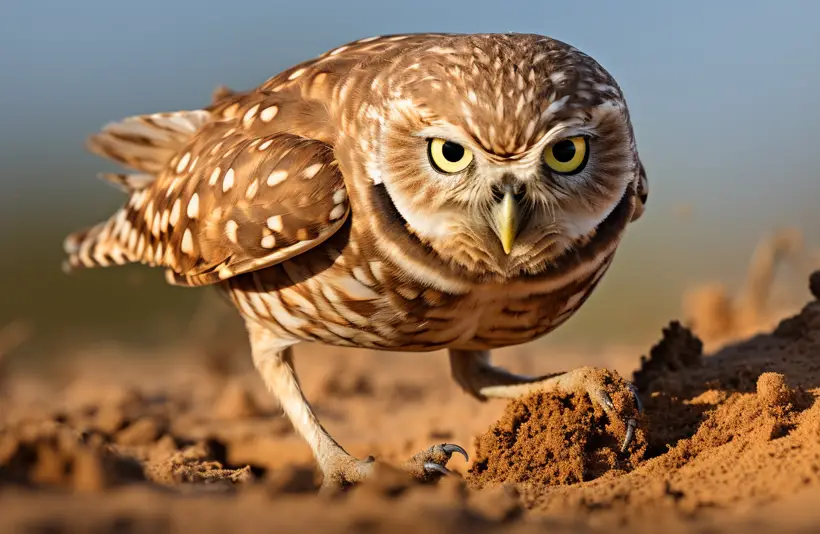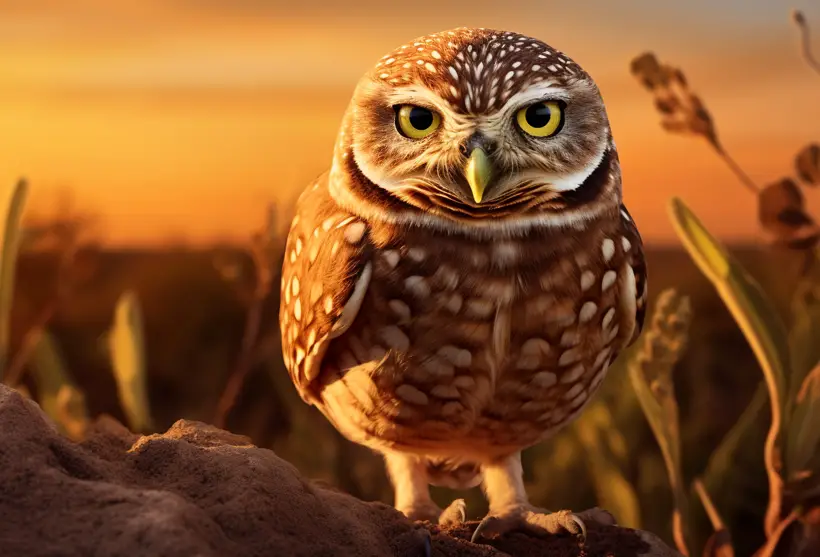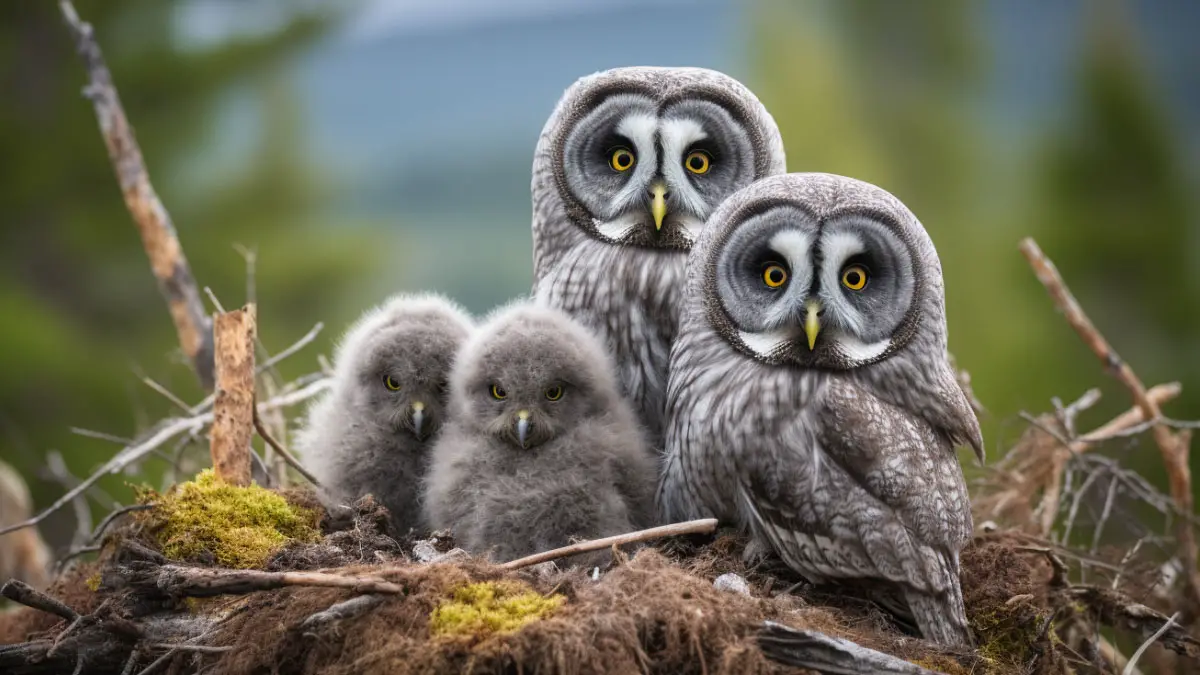Small, nocturnal owls called burrowing owls are renowned for their unusual looks and extraordinary habits. They stand out in the avian realm because of their remarkable eating habits.
Now come to the question of what do Burrowing owls eat. The varied diet of a burrowing owl includes insects and small animals like mice. They can survive in grasslands and other open settings thanks to their versatile diet. Additionally, they eat reptiles, small birds, and amphibians. Also, they have developed distinctive hunting strategies to capture a variety of prey.
Burrowing Owls are excellent hunters, like other owl species, despite their diminutive size. Continue reading if you want to learn more about the burrowing owl’s dietary habits.
What Do Burrowing Owls Eat?
The diversified food habit of burrowing owls makes them opportunistic hunters.

Primary Dietary Components
- Small mammals: Rodents like voles, mice, and ground squirrels make up a sizable component of the food of small mammals.
- Insects: Crickets, beetles, and other insects are also significant sources of food.
- Reptiles and Amphibians: On rare occasions, they may consume reptiles and amphibians as food such as lizards, snakes, turtles, and frogs.
- Small Birds: They may occasionally catch small birds like sparrows and swallows.
Preference for Small Mammals
Burrowing owls are particularly skilled at catching small animals due to their hunting strategy and accessibility. These creatures such as voles, mice, and ground squirrels make up a substantial portion of their food.
What Do Young Burrowing Owls Consume?
The food of young burrowing owls initially consists of tiny, easily digested prey items supplied by their parents. Grasshoppers, beetles, and crickets are just a few of the many insects that commonly make up these prey items.

As the owlets mature and expand, their diet progressively changes to include larger food. Mostly rodents and other small animals, which give the owlets the nutrition they need for rapid growth. Until the baby owlets can hunt for themselves, the parents hunt and supply food for the young owlets.
What Type of Liquid Do Burrowing Owls Consume?
Like the majority of birds, burrowing owls get the majority of their moisture from the food they eat. Unlike mammals, they don’t normally drink water. They often get enough water from their food, which includes insects and small animals.

However, especially during dry conditions, they will drink water when it is accessible in their habitat. Such as from puddles or tiny bodies of water. They may drink more often when kept in captivity or given access to water sources. But in the wild, they depend on the moisture provided by their prey.
What Food Items Can You Give Your Pet Burrowing Owls?

Burrowing owls kept as pets in captivity must be fed with great care. The following recommendations are for feeding pet burrowing owls:
- Commercial Owl Diet: High-quality commercial owl meals created exclusively for raptors are readily accessible. These diets, which frequently come in pellet or frozen form, are made to fit their dietary needs.
- Whole Prey Items: Offering complete prey items, such as mice, rats, and chicks, in addition to commercial meals, can give animals nutrients. These need to be suitable for the age and size of the owl.
- Supplements: Consult with an avian veterinarian to see if your owl requires any nutritional supplements. Supplements for vitamins and minerals should only be given under medical supervision.
- Insects: You may give your pet insects like mealworms and crickets as treats or as a meal. Make sure they come from reliable sources whether they are live or freeze-dried.
- Water: Always give your owl access to clean, fresh water. While they may occasionally sip water, their main source of moisture comes from their prey.
- Variety: Providing a range of food options promotes a balanced diet and guards against nutritional deficits.
It’s important to learn about and comprehend the particular nutritional needs of the burrowing owl species. Additionally, to preserve their health and well-being, captive owls should be provided a diet.
This video might help you understand which type of food should be given to pet burrowing owls.
Dietary Adaptations
The following modifications that burrowing owls have developed to fit their food and lifestyle.
Adaptations to Diet and Burrowing Lifestyle
- Digging Skills: Their strong beaks and cutting talons allow them to dig tunnels for breeding and safety. This also helps them to reach prey that is buried underneath.
- Diurnal activity: Because they are diurnal, they are active during the day. This is consistent with the behavior of many of the small mammal prey species they feed on.
- Transportability of Prey: Due to their tiny size, rodents can more easily take food to their burrows.

Value of a Diverse Diet
Their existence depends on a diversified diet for some reasons:
- Nutritional Balance: The nutritional value of various prey items is changed, ensuring they acquire the necessary vitamins, proteins, and lipids. If their daily requirement is not fulfilled then they hunt for more giant animals.
- Adaptability: Their capacity to adjust to variations in the availability of prey, which might alter due to season change. They adapt for environmental reasons, which is facilitated by their varied diet.
- Reproductive Success: A diversified diet during breeding season guarantees that they may provide their chicks with balanced and nutritious food. Because their offspring cannot hunt they hunt, so they need to ensure proper food for the offspring.
Burrowing owls may successfully hunt and rear their young in the security of their burrows. This is because of their sensory acuity, varied food, and adaptations to living in grasslands.
Seasonal Dietary Variations
The burrowing owl’s diet can indeed alter with the seasons. This reflects the availability of prey and the unique requirements of each season.

Dietary Changes with the Seasons
- Spring and Summer: Burrowing owls frequently concentrate on collecting small animals, notably rodents and insects. These consumptions of small animals give a boost to the diet. These prey animals offer a high-protein food that helps the development and growth of their chicks.
- Fall: As fall approaches, various nutritional changes might take place. While insects and small animals are still significant, there may be a rise in insect consumption.
- Winter: Dietary preferences can shift even more in areas where burrowing owls suffer colder winters. Small animals may slow down or hibernate in winter. This makes owls more dependent on insects and other readily available food sources.
Dietary Changes During Migration and Breeding
- Breeding Season: Owls during breeding their offspring frequently give priority to a diet full of high-energy food, such as rodents. This guarantees that mothers can give their chicks the nourishment they require to flourish.
- Migration: Some burrowing owl populations migrate, and this can cause major dietary changes. For sustenance on their protracted migration paths, they may depend on a greater range of food. Burrowing owls at the time relied on insects, squirrels, and small birds.
It’s vital to remember the precise date of the mating season and migration. As well as the location, local prey availability, and nutritional adjustments, can all vary. To tailor their diet to the needs of shifting seasons and life stages, burrowing owls show flexibility.
Impact of Human Activities on Burrowing Owl Diets

Burrowing owls’ diets may be significantly impacted by human activities, especially habitat loss and modification:
- Loss of Habitat: The owls’ preferred prey species, such as rodents, depend on grasslands and open habitats, which are frequently destroyed. Reduced prey availability may be the result of this loss of appropriate habitat.
- Use of Pesticides: Using pesticides in agricultural regions can hurt the number of insects. Pesticides pose threats to owls and their prey by reducing insect populations and contaminating prey.
FAQs
These are some commonly asked questions by people about what burrowing owls eat.
Rattlesnake predation by burrowing owls is not a common occurrence. While rattlesnakes are a variety of their prey, including reptiles, they do not eat them frequently. When there is insufficient food, then burrowing owls hunt rattlesnakes.
In general, chickens are not a component of the normal diet of burrowing owls. These owls are more likely to hunt insects, small animals, and other types of wildlife. Predation on domestic poultry can happen on rare occasions, although it isn’t usually a behavior for them.
No, as they are carnivorous birds, burrowing owls do not include vegetation in their diet. They only eat animal products because they lack digestive adaptations.
Conclusion
These endearing birds are opportunistic predators who mostly target insects and small animals. However, because of their adaptability, they may also occasionally eat tiny birds, amphibians, and reptiles. In order to ensure that they obtain the nutrients it is crucial to understand their dietary requirements.
By reducing insect populations, burrowing owls also perform crucial roles in their ecosystems. These amazing birds continue to enchant us with their distinctive foraging strategies and endearing habits. Despite the fact that their diet may change depending on the availability of food.








